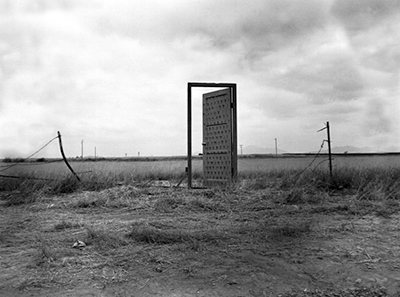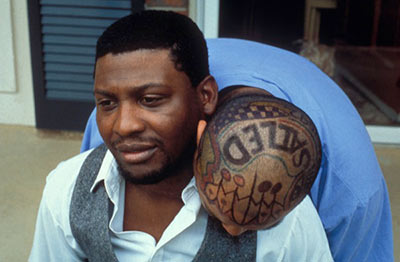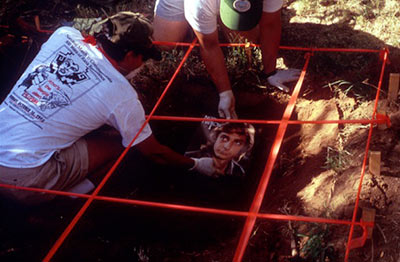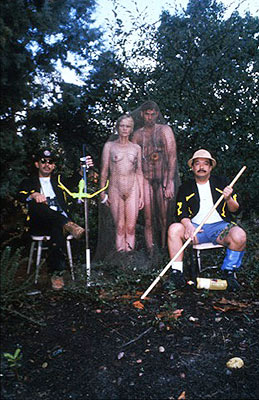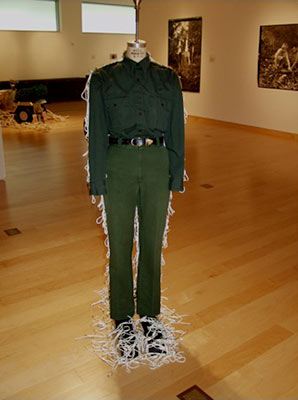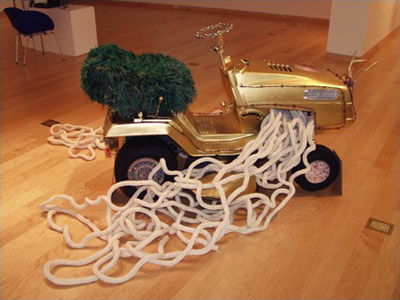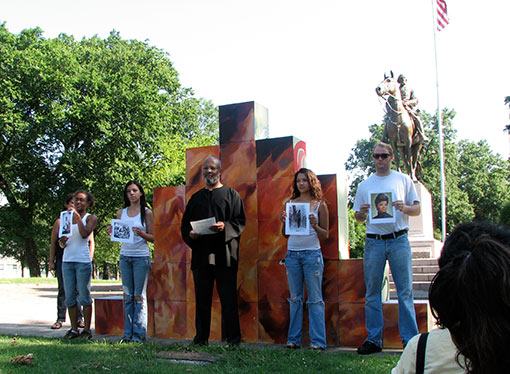A freestanding door rests on a barren field along the international border between the United States and Mexico inviting would-be immigrants to walk through it. A decade later, and not too far from where that door was located, a group of Chicano “anthropologists,” Drs. Lou and Sánchez,1 capture a pair of fine “specimens” from a disappearing tribe called the “Colorless,” last remnants of white European culture in United Aztlán, formerly known as the United States of America. These are two of the many imaginative and politically provocative scenarios created or co-created by performance and multimedia artist Richard Lou, who has been committed to the practice of border art for over twenty years. Border art can be defined as forms of creative expression that focus on the social, political, and cultural realities of life in regions like the U.S.-Mexico border, but can also speak to the broader experience of marginalization and oppression due to the imposition of invisible yet socially-restricting borders. A child of the borderlands himself, Lou was born and raised in the Tijuana/San Diego border region to a Mexican mother and Chinese father and, as such, gained a heightened understanding of the border experience, an experience marked by marginalization and disenfranchisement, but also by resilience, resourcefulness, and creativity. The hybridity and transnationalism of his origins later informed his work as a visual artist and led him to become a pioneer in border art. Lou’s artwork embodies what cultural theorist Nikos Papastergiadis calls “the semiotics of hybridity” or the language of hybridity that “becomes a means of critique and resistance to the monological language of authority” (170).
Like Papastergiadis’ definition of the hybrid text, Richard Lou’s work strives to undo “the priorities and disrupts the singular order by which the dominant code categorizes the other” (Papastergiadis 170). In this essay, I will engage in visual and textual analyses of his work, impart the various insights the artist has relayed to me during personal conversations, and share my own experience as a witness to one of his site-specific performances. I will ultimately argue that Richard Lou’s work is an example of what feminist philosopher Chela Sandoval and I call artivist aesthetics (Sandoval and Latorre), that is, his art epitomizes the convergence of creative expression, social activism and self-empowerment that characterizes much of the work of twenty-first-century artists of color in the United States and elsewhere.
Border Consciousness and Artivist Aesthetics
Richard Lou’s body of work embodies an increasingly fluid understanding of what is a border experience. While much of his work in the 1980s dealt directly with the physical location of the U.S.-Mexico border, his latter images alluded more explicitly to the psychic and discursive borders that were just as “real” as the actual fence that separates these two countries. The artivist aesthetics that emanate from the work of Richard Lou are a virtue of his bordered identity, both as an individual and an artist. I have argued elsewhere together with Sandoval that the term artivism refers to “a convergence between ‘activism’ and digital ‘artistic’ production,” a phenomenon that is “symptomatic of a Chicana/o twenty-first-century digital arts movement.” We further maintained that artivism is “a hybrid neologism that signified work created by individuals who see an organic relationship between art and activism” (Latorre and Sandoval 82). Artivism is also fueled by a commitment to a transformation of the self and the world through creative expression. Like other artists of color seeking to do politically transformative work, Lou’s artivist aesthetics betray a desire for egalitarian alliances across difference through shifting visual and discursive vocabularies. While he identifies as a Chicana/o artist, his allegiances and modes of expression transcend any monolithic understanding of a Mexican American identity. It is thus my argument here that artivist aesthetics are important properties of border consciousness, for these are the creative strategies that emerge from the hearts and minds of border inhabitants. Artivism is both a strategy of survival and a necessary creative response to oppression; like Lou’s work itself, artivism is politically provocative yet open to multiple meanings and interpretations.
Early Work
Lou came of age as an artist in the mid-1980s during what could be called an artistic renaissance taking place in the San Diego/Tijuana border region. Many politically active artists of the area became increasingly aware and critical of the growing militarization and fortification of the border fence between Mexico and the United States, and they sought to expose the heightened social inequities and discriminatory practices these changes brought about for the lives of disenfranchised peoples. They insisted upon recognizing that the current border realities were indeed a continuation of the region’s history of colonialism and expansion. In other words, the erection and subsequent militarization of the border represented for these artists and activists a postcolonial legacy that had its roots in the sixteenth-century Spanish colonization of the U.S. Southwest and the nineteenth-century Anglo-American expansion into Mexican territory. These artists’ political and artistic activities—often functioning as one and the same—would center around the 1,969 mile-long border fence that scarred their physical and social spaces. Shortly after graduating with an MFA from Clemson University in South Carolina, Lou would return to San Diego/Tijuana and become a key figure in the burgeoning border arts movement taking place there. He shared with his colleagues not only their decolonizing visions but also an interest in the border, both as a subject matter for his art and as a prop or medium for performance and site-specific work. Mirroring art critic Erika Suderburg’s broader definition of site-specific installation art, border artists understood that the site of their work was in and of itself “part of the experience of the work of art” (4).
In 1988 the Border Art Workshop/Taller de Arte Fronterizo (BAW/TAF) invited Lou to contribute to their annual show at El Centro Cultural de la Raza, San Diego’s premier Chicana/o, Latina/o, and indigenous exhibition space. Rather than create a work for the specific site of El Centro, Lou looked to the border itself as the necessary location for this project.2 His installation consisted of a free-standing door hinged on a frame he literally placed on the border, just a few miles from the Tijuana International Airport (Figure 1).
Fig. 1. Richard Lou, Border Door (1988). Site-specific performance/installation, U.S.-Mexico border, ¼ mile from the Tijuana International Airport and the neighborhoods of la Colonia Roma and la Colonia Altamira, Tijuana, Mexico. Photo by Jim Elliott.
Lou hammered dozens of nails on the door and hung 134 keys from its surface (Berelowitz, “Border Art” 164). He designed the frame in such a way that the door could only be opened from the Mexican side of the border thus operating as a symbolic portal inviting immigrants to cross “with dignity,” as Lou explained: “When Mexican migrant workers cross they are forced to do it in a humiliating manner. They have to crawl under the barbed wire or through the drainage pipes and run in the darkness like frightened animals” (Border Arts Workshop 6). The inspiration for this site-specific installation did not only come from the politicization around border issues he experienced in the San Diego/Tijuana border art scene; it also stemmed from having been personally affected by immigration policies himself. Immigration authorities had deported his wife while they were still dating and raided her place of work (Berelowitz, “Spaces of Home” 337), an experience that had been deeply traumatic for both of them.
Already in this early installation, Lou was attempting to merge political and aesthetic elements into his work, another characteristic that defines the aforementioned artivist sensibility. While with The Border Door Lou was seeking to make a socio-political statement, there is little doubt as to the way in which this installation aesthetically transformed the space surrounding it. Suderburg argues that site-specific installations often engage “the aural, spatial, visual, and environmental planes of perception and interpretation” (2). Indeed, The Border Door was a sight to behold in the barren and foreboding landscape of the border region, often described as no-man’s land, a place where people pass by but never stay. Aside from providing a symbolic portal into a dignified existence in the United States, The Border Door also transformed the space of the border itself thus disrupting the desolate and inhospitable environment of the region. Doors such as these are often associated with notions of home while also signaling the transition between public and private spaces. Lou was not only responding to the public denigration of undocumented immigrants, but also to the vilification of the border itself as a space of vice, criminal activity, and alterity. For Lou, as well as for many of his colleagues in the border art scene, the border was also a site of cultural citizenship, hybridity, and possibility, operating as the permanent home to entire populations. As such, the physical locality of the border deserved the same respect as state-sanctioned public spaces in Mexico and the United States. But Lou’s transformation of the border space proved to be short-lived. The Border Patrol took down the piece after only two days in situ, thus preventing many people from seeing it in its original location.
Lou’s artivist sensibilities endowed him with a heightened understanding of social processes and power dynamics. As such, he realized site-specific work could only be truly significant if it included a community-engagement component. As a performative extension to The Border Door, Lou visited local colonias (working class neighborhoods) and a shelter house for the poor called Casa de los Pobres [Home of the Poor] in Tijuana to hand out additional keys, thus encouraging people to cross through his door (Border Arts Workshop 46). Lou documented the reaction of the various individuals who received keys, encountering everything from confusion to knowing recognition of Lou’s intentions as a community-driven artist. Children, the artist was surprised to find out, were most receptive to his project:
Children immediately surrounded me. As I described The Border Door, the kids became very excited and promised to distribute the rest of the keys. I watched these young emissaries run like new ideas, scattering to fill a void. I wished them well and walked back home crying because I knew in my heart and mind that what I was doing was right. (Border Arts Workshop 46)
Ultimately, the artwork was not contained in the door itself, but rather in the intangible yet profound community interactions and alliances he forged in the process. The distribution of the keys was the means by which he built these community bonds allowing him to spread information through the dissemination of everyday objects. Like Brazilian artist Cildo Meireles who, in a multimedia project entitled Insertions Into Ideological Circuits (1970), wrote subversive messages against his country’s political regime on Coke bottles and bank notes and then put them in circulation through the country’s economic system, Lou’s keys held a similar function, for these moved through social networks in Tijuana’s colonias, disseminating decolonizing knowledge and subversive critiques of the social structures that maintain the border.
The Legacies of Conquest and the Colonized Body
With the advent of the 1990s, Lou’s work became increasingly performative and conceptual. While still engaged in border issues, much of his art from this period focused more on symbolic and discursive impositions of borders. He situated his own body at the intersection of these borders by engaging in public interventions that involved his own figure and personal interaction. Lou was well aware of how racialized, gendered, and classed bodies like his own operated within colonial and postcolonial social systems. He was conscious—like the postcolonial scholars Bill Ashcroft, Gareth Griffiths, and Helen Tiffin—that colonized and marginalized peoples have “a heightened level of bodily self-consciousness, since it is the body which is the inescapable, visible sign of their oppression and denigration” (Ashcroft, Griffith, and Tiffin 321). Many of his works from this stage in his career sought to expose the seams that held together racial, gender, and class constructs. The colonial body functions to legitimize systems of power and hierarchies of knowledge, yet it is itself illegitimate within this very system. But because the body is such a crucial site of colonial inscription, it has also become the very site of resistance for many artivists like Lou. Indeed, Ashcroft, Griffiths, and Tiffin remind us that the “body, too, has become then the literal site on which resistance and oppression have struggled” (322). This process is also in part an act of reversal whereby the colonized takes control of his/her own representation thus disrupting some of the power dynamics of objectification (Boehmer 269).
Fig. 2. Richard Lou and Robert J. Sánchez (featuring Robert Spencer), Headlines (1992). Performative and photographic project. Photo by Jo Carol Mitchell.
In 1992, precisely on the 500th anniversary of Columbus’s arrival in the Americas, Lou staged a performative photographic and video piece entitled Headlines (Figure 2). During the course of this project the artist shaved his head on a monthly basis and invited other artists and cultural producers to write texts or make drawings on his scalp asking them to articulate, according to Lou, “the issues of the conquest and the Americas” (“Headlines” 159). This very act operated as a literal manifestation of the ways in which colonization inscribed itself on the bodies of the colonized, literally and figuratively. On the one hand, the bodies of indigenous and African peoples were used as a source of labor for European powers to extend their empires into the Americas, and, on the other hand, these same bodies were deeply coded with discourses of inferiority and otherness in spite of their critical role in building colonial institutions. The texts and images the artist had inscribed on his head were like tattoos that aligned Lou with a stigma of criminality and suspicion. Elleke Boehmer argues that when British explorer James Cook encountered New Zealand’s Maori in the 1770s he was immediately struck by their tattooing, which for Cook signified “the ultimate sign of their difference or weirdness” (270), thus linking their external appearance to their allegedly savage inner character and assumed backwards social practices. Lou put this coding to the test when he engaged in the routine of his daily life wearing these “tattoos:”
As I lived with these graphics/text on my head, negotiating through my everyday activities, such as grocery shopping, eating out in public places, renting videos, freeway driving, teaching at Mesa College [San Diego], neighbors, family outings, I escalated a perceived threat. As people of color, the dominant culture perceives us automatically as a threat, and as a large bald person of color with graphics/text drawn on my head that anxiety is heightened. (“Headlines” 159)
Ultimately, this performance piece emerged from the artist having experienced what Frantz Fanon called “being dissected under white eyes, the only eyes” (325). With Headlines Lou commented on how the Latino male body, like that of other colonized and racialized peoples, is systematically criminalized and routinely transformed into the animalistic Other, and that this reality is indeed a modern-day manifestation of the colonial legacy.
In Headlines, however, Lou complicated the colonial and postcolonial binaries of us vs. them, civilized vs. savage, progress vs. backwardness, etc., by having mostly artists of color such as Guillermo Gómez-Peña and Robert Spencer inscribe these texts and images on his head, thus disrupting certain power dynamics that come with the territory. Hence, what does it mean for colonized subjects to mark the body of another colonized body? Did Lou make himself vulnerable and even subordinate to his colleagues’ inscriptions? What Lou proposes with Headlines is a different relationship between individuals in a postcolonial world. While during his daily activities in the public sphere he provoked mistrust, suspicion, and even fear, his exchanges with his fellow artists were rooted in relationships of trust, dialogue, camaraderie, and collaboration. Even though the Latino/mestizo male body is often rendered subordinate and inherently inferior by the U.S. status quo, Lou exposes the artificiality and constructedness of this paradigm by providing alternative relationships that do not require these forms of domination and control. Society creates social, political, and psychic borders that facilitate the creation and maintenance of hierarchies and asymmetries of power. With Headlines Lou denounces the existence of these borders while also imagining the possibility of decolonial existence.
The relationship between the bodies of the colonized and colonizer became a theme that would recur in Lou’s work throughout the 1990s. By using performance and his own body he continued problematizing and even inverting relationships of power between these bodies, often in provocative and contentious ways. Together with his colleague and long-time collaborator Robert Sánchez, Lou established a multimedia and performative installation project entitled Los Anthropolocos, loosely translated into “the crazy anthropologists.” With this project the artists expanded the scope of performance art by creating an entire narrative along with a fictive scenario and imaginary characters. With Los Anthropolocos, the artists adopted the performative personas of Drs. Ritchie A. Lou and Bobby J. Sánchez, two Chicano anthropologists whose mission is to discover and study “White” ethnicity. They live in a fictional future in which the United States as a nation-state no longer exists, having been replaced by the Chicano-dominated and -controlled United Aztlán. European and “White” culture in North America (or the “Colorless Empire”) has all but vanished, leaving mostly fossilized and archaeological traces behind. In order to make this fictitious narrative come to life, Lou and Sánchez photographed and filmed themselves in various different scenarios and poses that documented their supposed anthropological exploits. Many of these photographs and videos were then displayed in museum installations along with props and descriptive narratives that detailed the various activities of these two “anthropologists.” In one photograph we see our two heroes hard at work at a dig site (Figure 3).
Fig. 3 Robert J. Sánchez and Richard Lou, Los Anthropolocos: Manilow L.P. Dig Site (1992). Performance. Photo by Jim Elliott.
They have carefully laid out a checkerboard grid and put on protective gloves, following proper excavation protocol. Their hard work has rewarded them with a prize finding, a gem from the height of the Colorless Empire, a piece of white exotica if you will: a Barry Manilow LP still in mint condition. The seeming absurdity of this scene echoes what Lou and Sánchez felt was the real-life absurdity that drives many archaeological digs, that is, the assumption that objects connected to particular cultures or civilizations can somehow embody the very essence of those long-gone communities. Moreover, the artists’ use of humor and satire in the Anthropolocos project fulfills a critically strategic purpose. As artists of color, Lou and Sánchez tapped into the regenerative and transgressive power of humor. I argue elsewhere that humor has been politically transformative for artists of color in the United States: “The uses of humor, wit, irony and satire in the work by these artists function […] as strategies of cultural survival as well as a means to expose racial, social and gender hierarchies in U.S. dominant culture” (Latorre, “Humor” 2). Humor also enabled these artists to engage in a politics of reversal that allowed them to imagine a world where the existing status quo was turned on its head, as they explained in their artists’ statement:
Instead of Caucasian anthropologists perusing and ascribing meaning to the remains of some exotic culture, Chicano anthropologists, operating within the same parameters of scientific inquiry and, of course, the expressed authority of the status quo, peruse and declare meaning to the remains of the white race or, as we have coined “them,” the “colorless.” (Lou and Sánchez)
Even though Lou and Sanchez were clearly engaging in satirical humor and irreverent performance tactics with this project, a serious and socially relevant critique of power and colonial institutions was at play with these performances. The artists were particularly interested in the ways in which anthropological discourse had traditionally disseminated knowledge about non-European peoples. Veiled under the tenets of intellectual rigor and scientific objectivity, this discourse had effectively fashioned a perfectly contained, exoticized, and docile colonial subject.
The reversal that was inherent to the Anthropolocos project became even more provocative when Lou and Sánchez posed the hypothetical question of what would happen if the white body suddenly became the colonized body. In a photograph from the project entitled Captives of Fate (Figure 4), the characters of Drs. Lou and Sánchez show off what could perhaps be the crowning achievement of their reputable careers: the capture of two “fine specimens” from the “Colorless” tribe that was previously believed to be extinct in United Aztlán. The artists accompanied this photograph with a descriptive text written from the perspective of these two fictional anthropologists:
After capturing and tranquilizing these two magnificent specimen Los Anthropolocos were overcome by a combination of euphoria and grief […] Had they reached the end of their life work, searching for and analyzing the Colorless? And what will become of these godless brutes? Will they be capable of learning a language beyond their customary grunt squeals and belches? […] Los Anthropolocos would begin their travel with the two specimens, to all major cities in United Aztlán and the world recreating a live dramatic reinterpretation of the capture of the Colorless. (Johnson 45)
Fig. 4. Robert J. Sánchez and Richard Lou, Los Anthropolocos: Captives of the Fate (1992). Performance. Photo by Jim Elliott.]
With this photograph and its accompanying narrative, Lou and Sánchez appear to push the boundaries of good taste and propriety, yet this recasting of the white body as the colonized body functioned as a mirror image of a history of representational violence that was far from fictional. Indeed, the artists were alluding here to the tradition in Europe and North America of putting non-Western peoples on display as spectacles of the colonial gaze. While the artists’ display of these two bodies seems outrageous and potentially offensive, it was less than one hundred years prior to this project’s creation that exhibitors at the St. Louis World’s Fair in 1904 put tribal and native peoples from around the world on display inside what were called “living exhibits” (Breitbart). A century before the St. Louis Fair, South African woman Saartjie Baartman was uprooted from her home in South Africa and put on display throughout Great Britain and France, where she became the epitome of extreme Otherness due to what Europeans at the time considered to be her extremely enlarged buttocks and genitalia (Gilman). Lou and Sánchez’s Anthropolocos project is then a critical response to this tradition of representational violence when it comes to the bodies of colonized peoples. Though seemingly incongruous and bizarre, the world of United Aztlán is not unlike Europe and North America up until the turn of the twentieth century. Moreover, Lou’s work during this time was part of a larger and concerted effort on the part of artists of color in the United States to denounce the objectification of non-European peoples using radical performative tactics. For instance, Mexican-Chicano artist Guillermo Gómez-Peña and Cuban American artist Coco Fusco collaborated on a performance piece entitled Couple in the Cage (1992), for which both performers dressed in stereotypical “tribal” attire and put themselves on display in various museums throughout the Americas and Europe. The radical tactics that defined all these performances were meant to aggressively critique and denounce the conquest of the Americas in 1992 but also to use humor as a way to diffuse some of the pain associated with the colonial condition.
A Move to the U.S. South: A Redefinition of Border Consciousness
Lou’s work underwent a critical transition when in the year 2001 he left the San Diego/Tijuana border region and relocated to the U.S. South, first to Milledgeville, Georgia, and in 2007 to Memphis, Tennessee. Even though Lou was no stranger to the American South since his graduate student days, this shift to a part of a country with a different history and cultural ethos to the San Diego/Tijuana border region significantly transformed his art. As an artist whose work was so connected to local histories and site-specificity, the history and political dynamics of the American South would inevitably seep into his work. While always retaining his interest in the Mexican and Chicana/o experience in the United States as well as in border issues, his life in Georgia and Tennessee made him increasingly aware of the parallels and affinities between this experience and the histories of slavery, lynching, and right-wing extremism that are endemic to the U.S. South: “The border is wherever we are. Being part of a subjugated group, [oppression] becomes easily identifiable for us within a larger racist society […] What I am doing here is really no different than what I was doing in San Diego or Tijuana” (Lou, Telephone Conversation). His move to this region also coincided with the beginning of the Bush-era, post-9/11 politics, characterized by growing militarism, a heightened anti-immigrant sentiment, and severe restrictions on civil liberties. Lou’s hybrid and artivist consciousness allowed him to make critical connections between different histories while also expanding his pre-existing ideas about border issues that had so defined his work in San Diego/Tijuana. The black/white divides he encountered in the South resonated with him, for these functioned as the psychic borders that defined life in states like Georgia and Tennessee operating similarly to the Mexican/Anglo divides of Southern California. Nevertheless, Lou did not simply transpose oppositional strategies from San Diego/Tijuana to the South, but rather developed new strategies that addressed the unique and specific histories of the South while maintaining his commitment to social justice and politically driven, site-specific work.
Created for museum spaces but addressing the specific location of the U.S. South, the two installations that most explicitly merged Lou’s experience with Mexican and Black populations were The Penance Machine for Operation Gatekeeper (2004) (Figure 5) and Low-Mower (2003) (Figure 6), the latter done in collaboration with Ainsley Eubanks, Roxanne Farrar, Bill Fisher, and Sang-Wook Lee.
Fig. 5. Richard Lou, Penance Machine for Operation Gatekeeper (2004). Mixed-media installation. Photo by Richard Lou.
Fig. 6. Ainsley Eubanks, Roxanne Farrar, Bill Fisher, Sang-Wook Lee, and Richard Lou, Low-Mower (2004). Mixed-media installation. Photo by Richard Lou.
With both pieces Lou used pre-existing or found objects and put them together in ways that demanded a critical reading of their meaning and use within U.S. national culture. In Penance Machine he dressed a mannequin stand with a Border Patrol uniform and attached one thousand nylon nooses to the uniform’s cloth. Individually, the uniform and the nooses have very distinct and seemingly unrelated histories, yet both signify experiences of trauma and violence for people of color. For Mexican and Chicana/o populations in the border region this uniform can elicit feelings of fear and persecution, even though within dominant culture the Border Patrol agent is often lauded as a heroic protector of United States law and values. The nooses, on the other hand, are intimately tied to post-slavery lynching by hanging and the intimidation of African American populations in the U.S. South, in particular freed slaves seeking voting rights and some degree of political power (Markovitz). While lynching was more prevalent in the nineteenth and early twentieth centuries, Jonathan Markovitz argues that “the act’s symbolic power has endured long after the practice of lynching has largely faded away” (xviii). Lou’s juxtaposition of the noose and uniform establishes a point of contact between the Brown and Black experiences in the United States, one marked by pain and humiliation. Interested in the legacy of lynching, the artist ultimately argued that “Operation Gatekeeper [was] another form of lynching.” Operation Gatekeeper was a U.S. government program instituted during the Clinton era and designed to prevent undocumented immigration to the country by means of fortifying the U.S.-Mexico border, augmenting the number of Border Patrol agents and introducing new border surveillance technologies. Critics of the program argued that Gatekeeper increased the criminalization of immigrants, casting them “as a threat to national sovereignty and the American social and economic fabric” (Nevins 11).
Like The Penance Machine, Low-Mower (2003) also explored the common histories of marginalization and oppression experienced by Latina/o and Black populations while also extending our understanding of the border experience. For this installation, Lou outfitted a lawnmower with various decorations and accessories that underscore this device’s connection to the Black and Brown experience in the U.S. South. About two years after moving to Georgia, Lou realized that riding lawnmowers were quite popular among middle-class, predominantly white households in suburbia: “The riding lawnmower as a labor-saving device indicates a certain level of wealth and privilege,” Lou explained. It is only the homeowner with “a large lawn to mow who can also afford to buy a riding lawnmower” (PowerPoint Presentation). In spite of the ease and comfort afforded by the riding lawnmower, many homeowners in the South still hired Black and Latino workers to mow their lawns with these devices, thus further bolstering their class and race privilege. For Lou, these workers were crossing over into an “all-White territory” within deeply stratified urban spaces, not unlike the Mexican undocumented immigrant who crosses into the United States to find work. This type of border-crossing, however, is legally and socially sanctioned because it allows these racialized bodies access to a white milieu only under the status of laborer. The whole scenario, of course, is reminiscent of the class and racial dynamics between white landowners and Black slaves in the old southern plantations. But with the installation Low-Mower, Lou and his collaborators sought to make the riding lawnmower into a Black/Latina/o artifact, thus bestowing upon these workers a certain degree of ownership over these machines and over the spaces where they move. As such, the artists transformed the lawnmower into a lowrider, that is, the type of customized cars with low suspensions, highly decorated exteriors and interiors that are often associated with Black and Latina/o urban youth cultures. Lou, together with his colleagues, painted the mower gold and accessorized it with Mexican lotería cards, a chrome chain steering wheel, a deer head, beads, barbwire and woven noodles. Cultural critic Brenda Jo Bright has argued that as a response to urban segregation and surveillance, youth of color turned to lowrider car culture as a way to create “an alternate cultural space for performance, participation, and interpretation” (91). Thus the customization of the lawnmower in the hands of these artists signified not only a transformation of this artifact’s social meaning but also a transformation of the imagined space surrounding it. The driver of this Low-Mower could not only claim ownership of the mower itself but also over the white middle-class neighborhoods where he “cruises.”
The political and ideological borders that are deeply entrenched in the South are self-evident in the urban public spaces where people congregate and enact their civic identities. Parks and recreational areas are often central to the public identity of a city or town and tend to masquerade as apolitical and neutral spaces. This spirit of civic pride and community-building veils the ways in which these recreational spaces can also mirror and even promote the existing segregation and marginalization within the urban sphere. In my previous work on public art, I have underscored how Chicana/o artists have traditionally used public art to challenge urban politics and practices that undermine the movement and access to cultural citizenship for people of color (Latorre, Walls of Empowerment 140–75). Moreover, urban studies scholar David R. Díaz also credits politically minded public artists since the late 1960s with addressing “the decrepit condition of urban recreational space” (146). Reacting to these politics of space as well as to the specific history of Nathan Bedford Forrest Park in Memphis, Lou began work on a site-specific installation that would uncover the hidden histories behind these spaces and, according to Lou, “provide counter-narratives and definitions to the symbol of white supremacy that is embodied in the Confederate equestrian memorial of Nathan Bedford Forrest at Forrest Park” (Artist’s Statement). Having lived in Memphis for only two years, Lou very soon became all too conscious of the city’s rich but also tumultuous history. Nowhere is the history of racism, lynching, and racial violence more explicit than in Nathan Bedford Forrest Park located on the edge of downtown Memphis. The park is dedicated to one of the city’s “forefathers,” Nathan Bedford Forrest, who gained much fame and notoriety as a wealthy plantation and slave owner, a Lieutenant General in the Confederate Army during the American Civil War, and a central figure in the founding of the Ku Klux Klan afterwards. What did it mean then for the city of Memphis to name a park after Forrest and honor him with an equestrian statue? What populations felt included and, most importantly, excluded by this monument and surrounding park? These were indeed some of the overarching questions that fueled Lou’s performance entitled ReCovering Memphis: Listening to Untold Stories (Figure 7), which took place in situ on June 20, 2009. The rhetoric of patriotism represented by Forrest’s figure repressed the histories of people of color in the region yet their presence remains very much part of the social and institutional formations of the city. Lou’s piece then sought to make these histories not only visible, but also palpable and significant.
Fig 7. Richard Lou, ReCovering Memphis (2009). Site-specific public performance. Photo by Guisela Latorre.
The enactment of ReCovering Memphis consisted primarily of the continuous assembly and disassembly of a 7½-foot pyramid made out of wooden blocks that volunteers would stack and take down throughout the performance. Placing the pyramid in a way that covered Forrest’s monument to the attending audience, the volunteers would create a different image each time the structure was built. The transitions between each assembly were marked with Black spirituals sung by the artist’s oldest daughter, Gloria Lou, and Jon Lewis, a local musician. Once each image was fully assembled, different speakers, all Memphis residents from diverse backgrounds, would stand in front of the pyramid and engage in oppositional forms of story-telling: Robert Bain spoke of the need for anti-lynching monuments to temper Forrest’s legacy as flames raged behind him; Elaine Blanchard reminisced about her childhood friendship with an African-American neighbor while overlapping images of the Mississippi River twisted and turned in the background; Francisco Flores recounted his experience with police harassment and profiling in Memphis while haunting images of a slave auction became his backdrop. The storytelling element in ReCovering Memphis then became an alternative to the dominant historical canon represented by the Forrest monument. As Lou commented:
I always talk about stories. I come from that background. My father was a wonderful storyteller, and my mother is a wonderful storyteller. In actuality that is how I entered into the visual arts, it was from writing because I was interested in writing before I became interested in the visual arts. (Telephone Conversation)
The performance closed with Augustin Díaz and Raúl Venegas, Aztec dancer and drummer, whose frenzied performance in and around Forrest’s monument seemed to momentarily alter the space and redefine its politics. For the artist, transforming the specific site of Forrest Park was of critical importance, given the disturbing history this locale celebrates, as Lou himself explained:
The site acts as an extension of confederate ideology, militarized, in a public space, a highly contested and conflicted historical site that profoundly questions the identity of a city through public spaces in regards to how we articulate our past, present, and future and the values that are promoted through our support of public spaces. (Artist’s Statement)
With ReCovering Memphis, Lou challenged and questioned the practice of creating a national heritage that is built, according to Stuart Hall, “through the objects and artifacts which have been made to stand for and symbolize [the nation’s] essential values” (74, emphasis in the original). Hall warns, however, that this heritage is “always inflected by the power and authority of those who have colonized the past, whose versions of history matter.” Moreover, he insists that “those who cannot see themselves in [heritage’s] mirror cannot properly ‘belong’” (74). While Lou did not plead for the removal of Forrest’s equestrian sculpture from the park, he insisted on a more inclusive version of heritage that advocated not only incorporating these counter-histories into the national imaginary but also embracing a more fluid and dynamic vision of nation. Lou’s refusal to privilege any one narrative during the performance of ReCovering Memphis promoted a hybrid understanding of history and a reconsideration of the role played by public spaces.
Conclusion
As students and scholars of border history and culture, what can we ultimately learn from Richard Lou’s body of work? His refusal to create, in most cases, a tangible and physical art object—one that cannot be commodified, bought, or sold—complicates facile descriptions and analyses of his work and places him within a bordered space vis à vis current art hierarchies. While he is often described as a performance artist, this category in many ways does not account for the complexity of Lou’s artistic endeavors and sensibilities. Art historian Oliver Parfitt argues that performance art does itself possess multimedia and self-reflective components making it a hybrid form of expression. For Parfitt and other art historians, the hybridity of performance art is defined solely by its ability to blur boundaries between artistic media and question the relationship between artist and audience, yet its history remains purely European and North American in origins and development. Lou’s work, however, pushes the definition of the genre/medium to include the performative elements that exist within non-European cultures and traditions. For instance, his inclusion of oral traditions through storytelling and his insistence on politically engaging the public sphere in pieces like The Border Door and ReCovering Memphis point to Lou’s connection to non-Western understandings of performance. While oral traditions define the cultures of many native peoples of the Americas as well as the colonized populations of Asia, Africa, and Oceania, the politicization of the public sphere aligns Lou’s performances with activist traditions among people of color in the United States. Richard Lou’s work can thus teach us about the limitations of hegemonic discourses about cultural production, but also about the politically subversive and decolonizing potential of challenging and even obliterating these very discourses. His investment in artivist politics and aesthetics, as mentioned earlier in this text, ultimately connect him to movements toward social justice yet distances him from political allegiances defined by monolithic and static understandings of social identity.
Works Cited
Ashcroft, Bill, Gareth Griffiths, and Helen Tiffin, eds. The Post-Colonial Studies Reader. London and New York: Routledge, 1995.Berelowitz, Jo-Anne. “The Spaces of Home in Chicano and Latino Representations of the San Diego-Tijuana Borderlands (1968–2002).” Environment and Planning D: Society and Space23 (2005): 323–50.
——. “Border Art since 1965.” Postborder City: Cultural Spaces of Bajalta California. Ed. Michael Dear and Gustavo Leclerc. London and New York: Routledge, 2003. 143–82.
Boehmer, Elleke. “Transfiguring: Colonial Body into Postcolonial Narrative.” NOVEL: A Forum of Fiction 26.3 (1993): 268–77.
The Border Arts Workshop/Taller de Arte Fronterizo. The Border Arts Workshop (BAW/TAF) 1984–1989: A Documentation of 5 Years of Interdisciplinary Art Projects Dealing with U.S.-Mexico Border Issues (a Binational Perspective). San Diego: BAW/TAW, 1988.
Breitbart, Eric. A World on Display 1904: Photographs from the St. Louis World’s Fair. Albuquerque: University of New Mexico Press, 1997.
Bright, Brenda Jo. “Remappings: Los Angeles Low Riders.” Looking High and Low: Art and Cultural Identity. Ed. Breda Jo Bright and Liza Bakewell. Tucson: University of Arizona Press, 1995. 89–123.
Diaz, David R. Barrio Urbanism: Chicanos, Planning and American Cities. New York and Oxon: Routledge, 2005.
Fanon, Frantz. “The Fact of Blackness.” The Post-Colonial Studies Reader. Ed. Bill Ashcroft, Gareth Griffiths, and Helen Tiffin. London and New York: Routledge, 1995. 323–26.
Gilman, Sander. “Black Bodies, White Bodies: Toward an Iconography of Female Sexuality in Late Nineteenth-Century Art, Medicine, and Literature.” Critical Inquiry 12.1 (1985): 204–42.
Hall, Stuart. “Whose Heritage? Un-settling ‘The Heritage,’ Re-imagining the Post-Nation.” The Third Text Reader on Art, Culture and Theory. Ed. Rasheed Araeen, Sean Cubitt, and Ziauddin Sardar. London and New York: Continuum, 2002. 72–84.
Johnson, Kaytie. “Los Anthropolocos.” Contemporary Chicana and Chicano Art, Volume II. Ed. Gary D. Keller et al. Tempe, AZ: Bilingual Press/Editorial Bilingüe, 2002.
Latorre, Guisela. Walls of Empowerment: Chicana/o Indigenist Murals of California. Austin: University of Texas Press, 2008.
——.“Humor and Hemispheric Consciousness: Chicana/o and Native American Contemporary Art.” Journal of American Studies of Turkey 18 (2003): 1–13.
Lou, Richard A. Telephone Conversation with Guisela Latorre. 22 Apr. 2009.
——. “Headlines: Voices from the Conquered—1992.” TDR 37.1 (1993): 157–60.
——. Excerpt from Artist’s Statement for ReCovering Memphis. Unpublished text provided to Guisela Latorre. n.d.
——. PowerPoint Presentation provided to Guisela Latorre. n.d.
Lou, Richard A., and Robert Sánchez. “Los Anthropolocos Artist Statement.” Carolina Arts. Sept. 2003. 1 June 2011 <http://www.carolinaarts.com/903uscs.html>.
Markovitz, Jonathan. Legacies of Lynching: Racial Violence and Memory. Minneapolis: University of Minnesota Press, 2004.
Nevins, Joseph. Operation Gatekeeper: The Rise of the “Illegal Alien” and the Making of the U.S.-Mexico Boundary. London and New York: Routledge, 2002.
Papastergiadis, Nikos. “Restless Hybrids.” The Third Text Reader on Art, Culture and Theory. Ed. Rasheed Araeen, Sean Cubitt, and Ziauddin Sardar. London and New York: Continuum, 2002.
Parfitt, Oliver. “Performance Art.” The Oxford Companion to Western Art. Ed. Hugh Brigstocke. Oxford: Oxford University Press, 2001. 19 Dec. 2009 <http://www.oxfordreference.com> .
Sandoval, Chela, and Guisela Latorre. “Chicana/o Artivism: Judy Baca’s Digital Work with Youth of Color.” Learning Race and Ethnicity: Youth and Digital Media. Ed. Anna Everett. Cambridge, MA: MIT Press, 2008. 81–108.
Surderburg, Erika., ed. Space, Site, Intervention: Situating Installation Art. London and Minneapolis: University of Minnesota Press, 2000.
Notes
2 The piece, entitled Border Tunnel and presented in the gallery of El Centro in the same year, was meant to be the documentation for the Border Door.
Author
Suggested Citation

This work is licensed under a Creative Commons Attribution-ShareAlike 3.0 Unported License.


